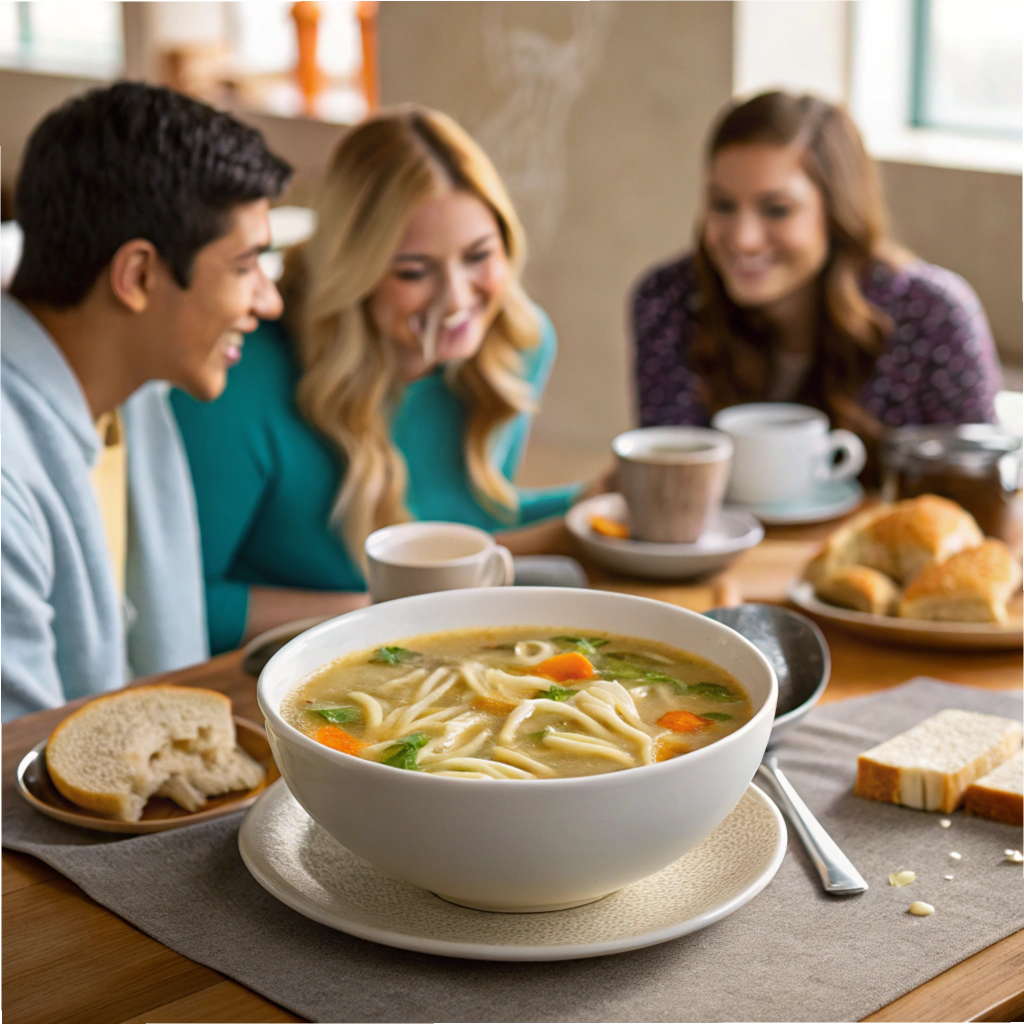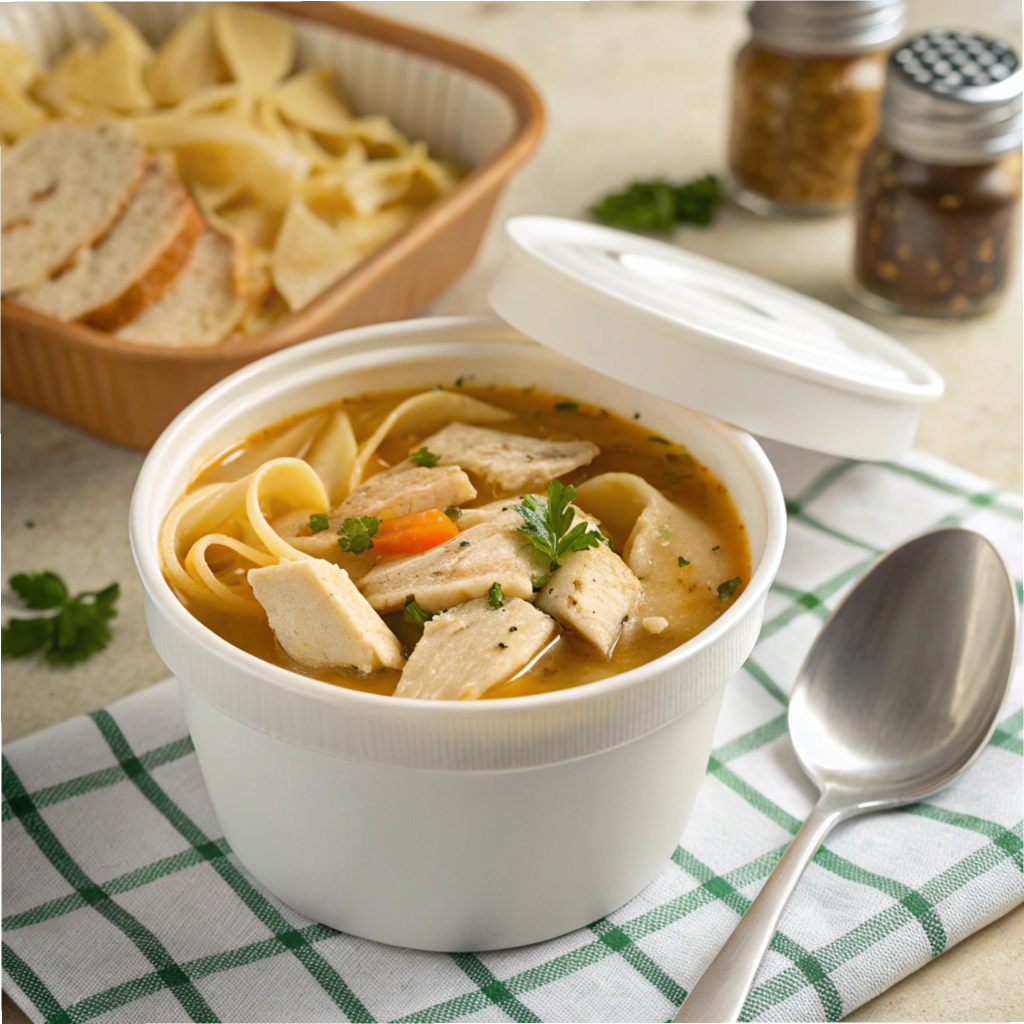
Panera Bread’s Chicken Noodle Soup has become a popular comfort food, but many wonder if it fits into a healthy diet. Understanding what makes a soup nutritious involves examining its ingredients, nutritional content, and how it compares to other meal options. Let’s explore whether Panera’s Chicken Noodle Soup lives up to its reputation as a wholesome and satisfying meal.
Why People Consider Chicken Noodle Soup a Healthy Choice
Chicken noodle soup has long been considered a go-to meal for those seeking comfort and nourishment. Its warm, savory broth, tender chicken, and nutrient-packed vegetables provide a balance of protein, vitamins, and hydration. But what makes this dish a symbol of health and healing?
Historical Perspective on Chicken Noodle Soup as Comfort Food
For centuries, various cultures have prepared versions of chicken soup to boost immunity, aid digestion, and soothe cold symptoms. In traditional medicine, warm broths were believed to have healing properties, offering comfort during illness. Modern science supports these claims, showing that chicken noodle soup can help clear nasal congestion, provide hydration, and offer essential nutrients.
What Defines a Healthy Soup?
Not all soups are created equal. A truly healthy soup offers a balance of macronutrients, essential vitamins, and minerals while minimizing unwanted additives like excessive sodium or preservatives.
Nutritional Balance in a Meal
A healthy soup should provide a well-rounded balance of carbohydrates, protein, and healthy fats. Ideally, the broth should offer hydration and electrolytes, while the vegetables should deliver fiber and essential vitamins. Protein from lean meats like chicken supports muscle maintenance and immune function.
Key Components for a Healthy Soup
- Fresh Vegetables: Look for soups with nutrient-rich vegetables like carrots, celery, and onions, which provide vitamins A, C, and K.
- Lean Protein: Chicken breast or thigh meat offers high-quality protein while keeping fat levels low.
- Whole-Grain or Egg Noodles: These provide sustained energy through complex carbohydrates.
- Low-Sodium Broth: A flavorful broth should contain minimal added salt to support heart health.
Why Evaluate Panera’s Chicken Noodle Soup?
With growing awareness about food quality and nutrition, many consumers question whether Panera’s Chicken Noodle Soup aligns with healthy eating principles. Its popularity stems from its homemade taste and perceived nutritional benefits, but how does it perform when examined closely?
Transparency in Food Labeling and Customer Expectations
Panera Bread has built its brand around clean ingredients and transparent food labeling. The company’s “No Artificial Preservatives” policy promises customers food that is free from synthetic additives. However, even health-conscious products can contain high sodium levels, prompting some to question the soup’s true health value.
Growing Focus on Health-Conscious Eating
The rise of health-conscious dining has pushed brands like Panera Bread to provide detailed nutritional information and offer healthier menu options. In response, Panera has developed recipes that meet specific dietary needs, including low-calorie and vegetarian-friendly options. Evaluating the nutritional content of their Chicken Noodle Soup helps determine whether it fits into today’s wellness-focused lifestyles.
By understanding what makes a soup truly healthy and considering Panera Bread’s commitment to clean, fresh ingredients, customers can decide whether their Chicken Noodle Soup supports a balanced diet. Next, we’ll dive deeper into its nutritional breakdown and how it measures up against health standards.
Nutritional Facts Overview: Panera Chicken Noodle Soup
Panera Bread’s Chicken Noodle Soup is frequently praised for its comforting taste, but how does it measure up nutritionally? By analyzing its macronutrients, vitamins, and mineral content, we can better understand whether it fits into a healthy diet. Here’s a detailed breakdown of its nutritional value per serving and its overall contribution to a balanced meal. Panera Chicken healthy soup
Macronutrient Profile
Calories per Serving
A standard serving of Panera Chicken Noodle Soup contains approximately 120-160 calories, depending on the portion size. This makes it a low-calorie meal choice that works well for individuals tracking their caloric intake. The soup’s broth-based nature keeps the calorie count minimal, making it suitable for lighter meals or snacks.
Protein Content from Chicken
Each serving provides about 10-14 grams of protein, primarily sourced from antibiotic-free chicken breast. This lean protein supports muscle repair, immune health, and overall body maintenance. Since protein increases satiety, this soup can help curb hunger, making it a great choice for those managing their weight.
Carbohydrate and Fiber Breakdown
Panera’s Chicken Noodle Soup contains between 15-20 grams of carbohydrates per serving, coming from its egg noodles and vegetables. The noodles provide quick energy, while the fiber from carrots, celery, and onions supports healthy digestion. Each serving includes approximately 2-3 grams of fiber, promoting gut health and helping regulate blood sugar levels.
Micronutrients and Vitamins
Essential Vitamins (A, C, K) from Vegetables
Vegetables like carrots, onions, and celery contribute a wealth of vitamins:
- Vitamin A: Found in carrots, supports eye health and immune function.
- Vitamin C: Boosts immunity and promotes healthy skin.
- Vitamin K: Helps with blood clotting and supports bone health.
These essential nutrients make the soup a nutrient-dense meal that promotes overall wellness.
Mineral Content: Sodium, Potassium, Iron
- Sodium: A serving of the soup contains approximately 700-900 mg of sodium. While this helps enhance the broth’s flavor, it may be too high for individuals monitoring their salt intake.
- Potassium: This mineral helps regulate fluid balance and supports heart function. It comes naturally from the soup’s vegetables and broth.
- Iron: Found in trace amounts, iron supports oxygen transport in the body and energy production. Panera Chicken healthy soup
Daily Value Percentages
How It Fits into a Balanced Diet
A single serving of Panera Chicken Noodle Soup contributes to several daily nutritional goals:
- Protein Needs: The soup covers about 20-25% of the recommended daily protein intake for most adults.
- Vegetable Servings: Its vegetable content provides about one serving of the recommended daily intake.
- Low Fat Content: With only 3-5 grams of fat per serving, the soup fits well into low-fat diets.

Understanding Portion Control
Since the soup’s nutritional content depends heavily on portion size, understanding serving recommendations is crucial. A regular cup provides a light meal or appetizer, while a bread bowl version significantly increases caloric and carbohydrate content. For a balanced meal, consider pairing a cup of soup with a fresh salad or fruit.
Summary of Nutritional Insights
Panera Bread’s Chicken Noodle Soup strikes a balance between taste and nutrition. Its lean protein, essential vitamins, and moderate carbohydrate content make it a nourishing meal. However, its relatively high sodium content could pose concerns for those managing their salt intake. Understanding its nutritional breakdown empowers health-conscious diners to make informed meal choices.
Key Ingredients in Panera’s Chicken Noodle Soup
The ingredients used in Panera Bread’s Chicken Noodle Soup play a significant role in defining its taste, nutritional value, and overall appeal. Understanding these components helps determine how healthy the soup truly is. Let’s break down its key ingredients, healthier additives, and potential concerns for those with dietary restrictions. Panera Chicken healthy soup
Core Ingredients That Support Health
Panera’s focus on fresh, natural ingredients ensures its Chicken Noodle Soup delivers both flavor and nutrition. Here are the essential components that make this soup a comfort-food favorite:
Fresh Vegetables: Carrots, Celery, and Onions
The soup features a classic blend of carrots, celery, and onions, often referred to as the “holy trinity” in cooking. Each vegetable adds distinct nutritional benefits:
- Carrots: Packed with vitamin A, carrots promote healthy vision and immune support.
- Celery: High in water content and fiber, celery aids digestion and hydration.
- Onions: Onions provide antioxidants, including quercetin, which supports heart health and reduces inflammation.
These vegetables also enhance the soup’s depth of flavor through natural sweetness and aromatic richness.
High-Protein Chicken Breast
Panera uses antibiotic-free, all-white meat chicken breast, which offers a lean protein source with minimal fat. Each piece is tender and well-seasoned, providing about 10-14 grams of protein per serving. This inclusion makes the soup a satisfying and muscle-supporting meal.
Egg Noodles for Sustained Energy
The wide egg noodles in Panera’s Chicken Noodle Soup add texture, heartiness, and carbohydrates for sustained energy. Made from wheat flour and eggs, these noodles provide a good balance of complex carbs that fuel the body throughout the day.
Healthier Additives or Preservatives
To maintain freshness and enhance the soup’s taste, Panera includes several natural additives. These components support the soup’s shelf stability while keeping it free from artificial preservatives.
Yeast Extract for Flavor
Yeast extract acts as a natural flavor enhancer, boosting the soup’s umami depth. It creates a savory, satisfying taste without the need for artificial flavorings. This additive is often used in clean-label recipes to enhance broth-based dishes.
Citric Acid for Freshness
Citric acid, derived from citrus fruits, serves as a natural preservative. It helps maintain the soup’s freshness by balancing its pH and reducing the risk of spoilage. Citric acid also adds a subtle tanginess, enhancing the broth’s overall brightness.
Ingredients to Watch Out For
While Panera prioritizes clean ingredients, some components may raise concerns for certain consumers, especially those monitoring sodium intake or managing allergies.
Sodium Levels and Their Impact
With about 700-900 mg of sodium per serving, Panera’s Chicken Noodle Soup falls within the higher range for soups. While sodium enhances the broth’s flavor, excessive intake can affect heart health and fluid retention. Those watching their sodium intake should consider pairing a smaller soup portion with a low-sodium side like a green salad.
Potential Allergens (Gluten, Eggs)
- Gluten: The egg noodles contain wheat, making the soup unsuitable for those with gluten sensitivities or celiac disease.
- Eggs: Since the noodles are egg-based, individuals with egg allergies should avoid this soup or request an alternative if dining in-store. Panera Chicken healthy soup
How Panera Manages Ingredient Transparency
Panera Bread is committed to transparency in its food labeling. Its “Clean Food” policy ensures that all menu items, including Chicken Noodle Soup, remain free from artificial preservatives, sweeteners, and flavors. The full ingredient list is publicly available on Panera’s official website, allowing customers to make informed choices.

Conclusion
By focusing on fresh vegetables, lean protein, and natural preservatives, Panera Bread’s Chicken Noodle Soup maintains a clean, nutritious profile. However, its sodium content and gluten-containing noodles may be points of concern for individuals with specific dietary needs. Being aware of these ingredients helps customers decide how this popular soup fits into their health and wellness goals.
Health Benefits and Concerns of Panera’s Chicken Noodle Soup
Panera Bread’s Chicken Noodle Soup is widely considered a nutritious and comforting meal. Its ingredients offer several health benefits, from boosting immunity to supporting hydration. However, like many prepared soups, it has a few potential concerns worth noting. Let’s explore its health advantages, potential drawbacks, and how it compares to homemade alternatives.
Health Benefits of Panera Chicken Noodle Soup
Positive Nutritional Aspects
Several elements of Panera’s Chicken Noodle Soup contribute positively to overall health. Its nutrient-rich ingredients and carefully prepared broth deliver essential vitamins, minerals, and hydration.
1. High Protein for Muscle Maintenance
The soup contains lean chicken breast, providing approximately 10-14 grams of protein per serving. Protein is essential for muscle repair, tissue health, and immune function. Since Panera uses antibiotic-free chicken, customers receive high-quality protein with minimal fat.
2. Vitamins and Minerals from Vegetables
Fresh carrots, celery, and onions contribute vital vitamins and minerals:
- Vitamin A from carrots supports vision, skin health, and immune defense.
- Vitamin C helps boost immunity and promotes wound healing.
- Vitamin K aids in blood clotting and bone strength.
- Minerals like Potassium and Magnesium regulate blood pressure and fluid balance.
3. Hydration and Electrolyte Balance from Broth
The broth serves as a hydrating base, replenishing lost fluids and electrolytes, especially after illness or exercise. Its clear, savory consistency makes it easy on the stomach, aiding in digestion and recovery.
Health Concerns to Be Aware Of
Despite its nutritional perks, Panera’s Chicken Noodle Soup has some drawbacks related to sodium content, calories, and potential allergens. Being mindful of these concerns can help customers make more informed dining choices.
1. Sodium Content: How Much Is Too Much?
One of the soup’s main concerns is its sodium content. Each serving contains approximately 700-900 mg of sodium, which accounts for about 30-40% of the recommended daily intake for most adults. While sodium enhances the broth’s taste and extends its shelf life, consuming too much can contribute to high blood pressure and fluid retention.
Tips for Reducing Sodium Intake:
- Choose a Smaller Serving: Opt for a cup instead of a bowl to minimize sodium intake.
- Pair with a Low-Sodium Side: A side salad with a light vinaigrette can balance out the meal.
- Make It at Home: Consider preparing a similar soup at home using a low-sodium broth.
2. Caloric Intake for Weight Management
While the soup itself is relatively low in calories (about 120-160 calories per cup), adding extras like a bread bowl can quickly increase the calorie count. A bread bowl alone adds around 600-800 calories, making the meal more indulgent than expected.
Healthy Pairing Tips:
- Pair the soup with a small side salad for extra fiber and fewer calories.
- Skip the bread bowl and choose whole-grain bread for added nutritional value.
3. Potential Additives or Preservatives
Though Panera avoids artificial preservatives, some natural additives like yeast extract and citric acid might concern sensitive individuals. These ingredients improve the soup’s flavor and shelf life but may trigger reactions in highly sensitive consumers.
Comparing Homemade vs. Store-Bought Soup
Is making chicken noodle soup at home healthier than buying it from Panera? While Panera emphasizes clean ingredients, homemade versions allow for complete control over sodium levels, ingredient quality, and portion sizes.
Panera’s Approach to Freshness
Panera prepares its Chicken Noodle Soup in small batches, ensuring freshness and consistent taste. Its “Clean Food” policy means no artificial additives, giving it an edge over many other fast-casual competitors.
Advantages of Homemade Chicken Noodle Soup
- Lower Sodium: Home cooks can use no-sodium or reduced-sodium broth.
- Customizable Ingredients: Extra veggies, whole-grain noodles, and organic chicken can improve the nutritional profile.
- Allergen-Free Options: Home preparation allows for substitutions to accommodate food allergies and sensitivities.
Final Thoughts
Panera Bread’s Chicken Noodle Soup offers a range of health benefits thanks to its nutrient-dense ingredients and clean preparation methods. However, being aware of its sodium content, portion sizes, and potential allergens can help customers enjoy this comfort food while maintaining a balanced diet.